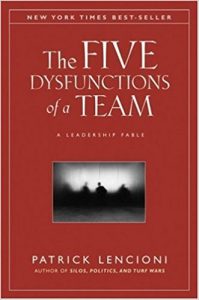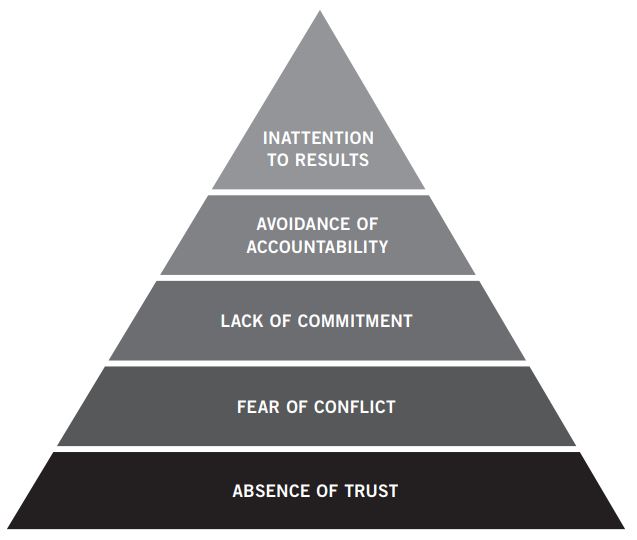 Patrick Lencioni wrote The Five Dysfunctions of a Team: A Leadership Fable in 2002. The popular book is about the imaginary company Decision Tech, and how a new CEO turned the company around. The CEO, Kathryn, molded her senior managers into a true team by addressing five dysfunctions she observed. Much of the fable focuses on a series of senior leadership retreats where Kathryn helps her team learn and address the dysfunctions.
Patrick Lencioni wrote The Five Dysfunctions of a Team: A Leadership Fable in 2002. The popular book is about the imaginary company Decision Tech, and how a new CEO turned the company around. The CEO, Kathryn, molded her senior managers into a true team by addressing five dysfunctions she observed. Much of the fable focuses on a series of senior leadership retreats where Kathryn helps her team learn and address the dysfunctions.
The book is a quick read and the easy-to-follow plot will appeal to readers of fiction. This Lean East blog post focuses on the final several chapters of the book (the non-fiction section) where the five-team dysfunctions are summarized. Do any of these issues occur on your leadership team?
Dysfunction No. 1: An Absence of Trust Among Team Members
A high-performance organization is built on trust. Team members must be willing to share, collaborate, and be vulnerable to one another without fear of reprisal. We have written about the Speed of Trust in the past, and dysfunctional teams need to begin by growing trust in each other and in the group.
Overcoming a Lack of Trust:
Teams must speak honestly and openly about individual and group weaknesses, skill deficiencies, and problems. As we discuss in our post about trust accounts, it takes time for individual team members to work with one another and build positive balances. Our favorite ways to build trust in a team include:
- Complete a facilitated strategic planning exercise (like a SWOT Analysis) that addresses organizational vulnerabilities as a prelude to addressing individual vulnerabilities.
- Examining team member personality profiles as part of an off-site retreat. Through active exploration, individuals will learn about the strengths and blind spots associated with typical personality/behavior styles. This then enables them to build practices for effectively communicating and collaborating with others.
- Help the team build their competence by completing an improvement project. The project’s success will build their confidence and trust in working together. The process will also identify any significant team issues that need to be addressed.
Dysfunction No. 2: Fear of Conflict
Teams are more valuable than individuals when they are synergistic. Similarly, great decisions are made more quickly when there is productive conflict in the discussion. Too many teams avoid confrontation and end up with poor decisions. The fear of conflict is a direct result of an absence of trust in a team. Improve trust in the team and the fear of healthy conflict evaporates.
Overcoming Fear of Conflict:
Lean East uses the Thomas Kilmann Conflict Mode instrument to help leaders and teams identify their typical conflict response and how that influences others. This proven tool can be shared with the team in a half-day workshop or also as part of a larger leadership development initiative.
One other tip for increasing healthy conflict at meetings is to use the Six Thinking Hats method. Assign different “hats” to the meeting participants to encourage the team to look at the issue from different points of view and avoid groupthink. Alternatively, encourage team members to “try on different hats.” Then, announce to the rest of the team their goal of using lateral thinking to examine the issue in a new way.
Dysfunction No. 3: Lack of Commitment
Once teams work well enough to make great decisions, then clarity and buy-in are essential to gaining commitment. It is critical that teams leave meetings confident, and thus no one is quietly harboring doubts about whether to support the agreed-upon actions.
Overcoming Lack of Commitment:
First, begin by addressing the first two dysfunctions. Then, work on a personal planning and review process for leaders and staff in the organization. We recommend each department or team have S.M.A.R.T. goals that support the overall strategic goals. Leaders must then meet with staff to explain and gain commitment to the goals. Team leaders can ensure continued engagement by monitoring achievement progress.
Patrick Lencioni’s Five Dysfunctions of a Team

Dysfunction No. 4: Avoidance of Accountability
High-performance organizations hold themselves accountable to achieving their goals. They must not fear productive conflict or difficult conversations when results don’t meet expectations. Members of great teams improve their relationships by holding one another accountable, thus demonstrating that they have high expectations and respect for each other.
Overcoming Avoidance of Accountability:
An effective personal planning and review process involves two-way communication between leaders and staff. This is to ensure that understanding is clear, commitment is established, and accountability is clarified. The Lean East process includes a “support required” section for each of the S.M.A.R.T. goals along with an identification of how the individual goal supports the team strategic plan.
We coach leaders on how to become “servant leaders” and develop their own behaviors and habits of coaching.
Dysfunction No. 5: Inattention to Results
Dealing with the first four dysfunctions doesn’t matter if the organization fails its mission or is forced to go out of business. Meeting individual and department goals are not enough. The organization must achieve success in its overall outcome-based performance. Every great organization specifies what it plans to achieve. These goals, more than the financial metrics they drive, make up the near-term, controllable results. Inattention to results manifests when team members focus on their individual status or individual department results. Therefore, detrimental to the organization as a whole.
Overcoming Inattention to Results:
We have seen many organizations where departments are well managed, but processes that cross multiple departments have many wastes. Organizations must measure results that customers value, and then ensure they only reward those behaviors and actions that contribute to those results. We recommend organizations share their goals as well as their results throughout the organization as key performance indicators. This promotes some healthy internal competition and also makes it easier to see which teams are struggling and need help.
Moving from Dysfunctional to High-Performance
Is your lead team functional or dysfunctional? Where do you need to improve? Are you able to identify the issues yourself, or would your team benefit from an outside assessment to help determine priorities?
If one or more of these dysfunctions are present in your lead team, then we recommend these initial actions:
- Build team trust through projects or workshops where the team learns and grows together. Every new and changed team progresses through stages of Forming, Storming, Norming, and Performing. Trust is the medium through which you can move through the stages and is at the root of all five dysfunctions.
- Improve team meetings so issues with conflict and commitment are addressed. An experienced yet humble leader (like Kathryn in the book) can do this on their own. Otherwise, leaders will benefit from some coaching and facilitation.
- Establish an organizational vision and strategic goals, and then implement a proven personal planning and review process. A good process will obtain commitment, set accountability, and ensure a focus on the vital-few results.
The benefits of having a high-performance organization are well worth the effort! Do you believe other dysfunctions should have been named in the book? Please share your thoughts in the comments section below.


Related Posts
The God Complex: Why We’re All Making This One Mistake
How I am Changing the Career Advice I Give My Kids
This is Never Going to Work: Getting Lean Projects Unstuck